Our editors independently select these products. Making a purchase through our links may earn Well+Good a commission
How To Care for an Elderly Pet With Love and Compassion, According to an Animal Behaviorist
Pets require special care to ensure they thrive in their golden years. Here, veterinarians offer advice on caring for an aging pet.

Aging comes for everyone, including our pets. As they get older, they require special care to ensure they thrive in their golden years, just like humans do. Many senior pets are susceptible to age-related health issues, such as arthritis and cognitive dysfunction, and these can often manifest in ways that aren’t so obvious. The best thing an owner can do is ensure that their senior pets are healthy and happy as they embark on this milestone. Ahead, licensed veterinarians offer their expert advice on how to care for an aging pet.
Experts in This Article
6 veterinarian-backed tips to help you care for older pets
1. Know your pet’s habits
Your pet’s habits will likely change as they age, and according to veterinarian and animal behaviorist Paola Cuevas, DMV, it’s important to observe how their habits evolve over time. Dr. Cuevas says to pay especially close attention to changes in their appetite, physical activity, sleeping patterns, and the frequency in which they urinate and defecate. If you notice any changes, or at least suspect them, it’s crucial to report them to your veterinarian, says Dr. Cuevas. “Behavioral and habit changes are usually signs of age-related health changes,” she explains. “This knowledge will help your veterinarian make an accurate diagnosis and thereby create an early management treatment for your pet.”
2. Schedule regular veterinarian check-ups
While essential to schedule routine check-ups for a pet at every age, it becomes all the more important for an aging pet. “Senior pets have higher chances of developing health issues,” says Dr. Cuevas—and many times, the warning signs of many health problems aren’t noticeable until they advance to later stages. Even the most attentive owners can miss the early signs of a health issue, and it doesn’t help that pets are unable to communicate how they’re hurting or mask their pain or discomfort—the latter of which is particularly common among felines. Dr. Cuevas encourages pet owners to schedule trips to the vet at least twice a year or more, depending on a pet’s needs. “An early diagnosis and treatment can increase the chances of recovery or improve management,” she says.
3. Ensure your pet continues to exercise
An aging pet isn’t often as limber as they were in their youth, and they can experience aches and pains, or even arthritis. While tempting to allow your companion to keep to the couch, it’s important that they continue exercising. “Just like humans, pets benefit from keeping active and moving,” says Dr. Cuevas, helping promote circulation, maintain a healthy metabolism, and preserve their muscle mass and mobility. That said, it’s essential to adjust your pet’s exercise accordingly to prevent exercise from becoming a painful endeavor. A senior dog with joint issues, for example, may benefit from shorter walks to avoid injuries.
4. Keep your pet sharp
Just as physical exercise keeps your pet healthy, mental exercises can keep an aging pet’s brain in optimal shape—which is especially important as many experience cognitive decline. Consider looking for age-appropriate toys that they can engage with without having to overexert themselves. Many senior dogs and cats won’t turn their noses up at enrichment toys, like food-dispensing puzzles, which come in varying levels of difficulty. You can also consider snuffle mats to encourage a pet’s foraging skills as they sniff around for treats and dry kibble between the mat’s fabric strands. Dr. Cuevas says that you can also make your own toys at home, using recyclable materials when you’re in a pinch.
5. Opt to change what your pet eats
If your senior pet has specific health needs, you might also want to consider making changes to what they eat—and the best way to determine which diet is best for your companion is to consult a trusted veterinarian. “The Association of American Feed Control Officials (AAFCO) has no standard for a senior pet diet for a reason—there are no specific senior diets that work for all pets,” says Dr. Cuevas. “The best diet for your pet will depend on its specific health needs.” With this in mind, ask your vet during a check-up if your pet can continue with its regular diet or if they could benefit from, say, a kidney or joint support diet, or one with few calories to avoid unhealthy weight gain.
6. Adapt your aging pet’s environment to their needs
Although an aging pet’s needs will vary widely, certain environmental changes can make their everyday life safer and more comfortable—and there are many products that cater to senior dogs and cats. Ultimately, though, “it’s important to consider your pet’s condition,” says Dr. Cuevas. Veterinarian Chyrle Bonk, DMV, shares this sentiment: “You don’t want to suddenly change things—especially if your older pet is experiencing cognitive decline or eyesight issues,” she adds.
What are common health issues for an aging pet?
According to both Dr. Bonk and Dr. Cuevas, many aging pets develop arthritis. “It can lead to mobility issues that can even affect [their] appetite and mood,” says Dr. Bonk. If your senior pet has arthritis, or develops it over time, a veterinarian can prescribe anti-inflammatory supplements or medications. Dr. Cuevas adds that some pets can benefit from physical activities that are easy on the joints, like swimming. Additionally, “environmental modifications can help a senior pet with arthritis,” she says, pointing to orthopedic beds for dogs and litter boxes with low entryways for cats as examples.
Care items for aging pets
If you’re looking to make environmental changes to accommodate your pet’s needs, these senior pet care items are worth consideration. Plus, they come with the recommendation of veterinarians.
A comfortable bed
“As pets get older, they start to slow down, have less energy, and sleep more,” says Dr. Bonk. “This makes a comfortable bed a must.” She adds that while most cats will prefer something they can cozy up in, senior dogs might benefit from using an orthopedic dog bed.

BedSure, Orthopedic Dog Bed — $37.00
Made with orthopedic foam, this dog bed supports joints and alleviates pressure. The bolster in the back offers senior pets a place to rest their weary heads. As a plus, the cover is machine washable.

Gavenia, Plush Pet Cushion — $24.00
This pet cushion is as comfortable as it looks. The faux-fur exterior is stuffed with a poly-cotton material to cradle your cat as they sleep. When it comes time to clean, simply throw it into the washing machine.
A ramp
If you’re caring for a senior dog, they might appreciate the leg up from a ramp when attempting to climb onto your couch or into your bed at night. Dr. Cuevas also mentions that it’s also great for canines who travel, allowing them to enter and exit a vehicle without strain.

Pet Gear, Stramp Stair And Ramp — $76.00
Portable and easy to assemble, this ramp lets senior dogs reach high places with little to no effort on their part. It’s replete with a textured surface that, as a bonus, catches any dirt under their paws.
A litter box with a low entryway
As mentioned by Dr. Cuevas, older or less-mobile cats will benefit from using a litter box with a low entryway. A low entry point lets them enter and exit the box with ease while preventing unnecessary strain on achy joints.
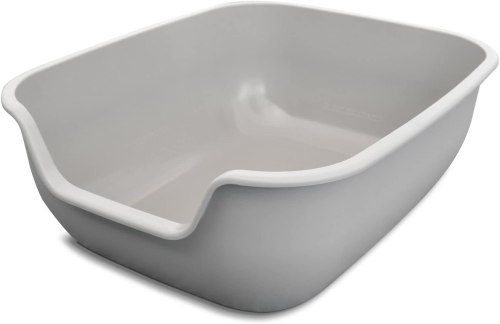
PetFusion, Better Box Non-Stick Litter Box — $38.00
With its 5-inch low entryway, this litter box is ideal for aging kits. Pet owners will also appreciate its non-stick surface and curved edges—two features that Amazon reviewers have reported make scooping out waste effortless.
Pee pads
If your dog has mobility issues, Dr. Cuevas says it might be helpful to have pee pads closeby, so they don’t have to travel too far to use the bathroom. Choose from single-use pee pads or a reusable option.

Amazon Basics, Dog and Puppy Pads (40-Pack) — $20.00
With over 200,000 Amazon reviews and a 4.5-star overall rating, these disposable pads are a popular option among pet owners. They are leak-proof and have five protective layers to keep urine off your floors. It’s available in up to packs of 150 and in multiple sizes.
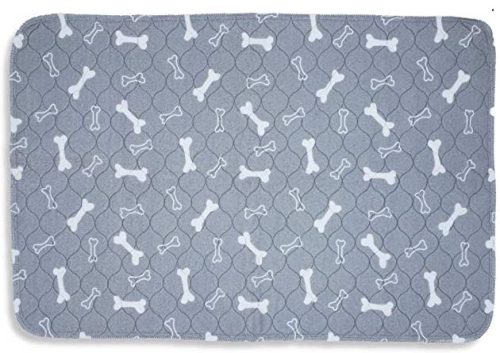
Raise The Woof, Washable Pee Pads (2-Pack) — $20.00
This pair of washable pee pads are an eco-friendly alternative to the disposable variety, making it ideal for long-time use. It features several layers to absorb urine, and a protective backing to keep your floors pristine. Plus, they are machine washable.
Elevated food and water bowls
Dr. Cuevas also recommends elevated food bowls for an aging pet, so they don’t have to bend down to eat or drink. Just keep in mind that they’re linked to a risk of bloating, so be sure to consult your vet if they’re best for your pet.
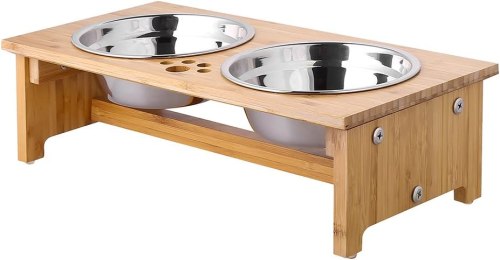
FORREY, Raised Pet Bowls — $22.00
This elevated feeder features two stainless steel bowls that are nestled in bamboo stands with an anti-slip surface. As a plus, the bowls are dishwasher safe, making them easy to clean. It comes in four options in varying heights—ideal for dogs and cats of most sizes.
Enrichment toys
As mentioned, enrichment toys are a wonderful way to stimulate your pet’s mind. While there are a variety of options available, it’s important to select the right one for your senior companion’s age and skill level, so it’s an enjoyable and not stressful experience.
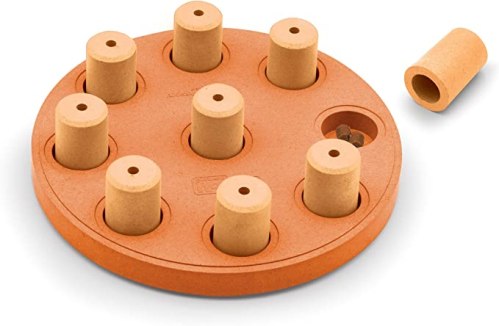
Nina Ottosson By Outward Hound, Interactive Treat Puzzle Game — $12.00
This hide-and-treat puzzle toy will encourage your dog to use their wits to uncover the treats hidden in one of its nine compartments. If your canine is up to the challenge, you can also choose among several options, which come with varying levels of difficulty.
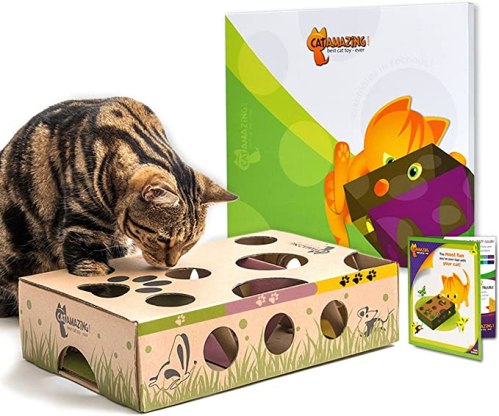
Cat Amazing, Cat Puzzle Feeder — $16.00
Made with felines in mind, this cardboard box puzzle is punctured with holes, where you can hide kibble, treats, and even catnip. Cats will have to use their senses to retrieve their reward. What’s more, you can modify the puzzle to make it easier or more challenging for your cat.
Sign up for the Well+Good SHOP Newsletter
Get exclusive deals on wellness, beauty, fitness, and food products that have been hand-picked by our editors.
Got it, you've been added to our email list.







